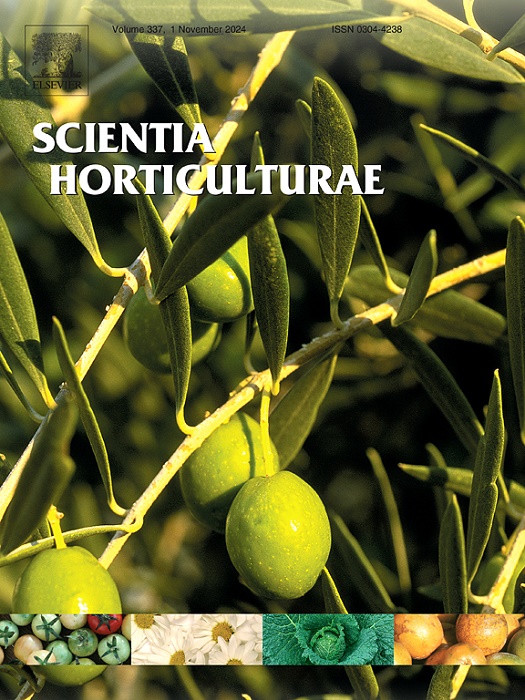The potential of sap conduction in the olive tree is linked to aridity conditions of the main cultivation area of varieties and allow to uncover their sensitivity to ongoing climate change.
IF 3.9
2区 农林科学
Q1 HORTICULTURE
引用次数: 0
Abstract
This study examines the impact of drought, and by extension potential water scarcity, on the potential of sap conduction in the olive tree, the emblematic fruit tree of the Mediterranean Basin. To understand adaptation of sap conduction potential of varieties concerning drought, we focus on wood anatomical traits in trees cultivated in the conservatory orchard of the 'Conservatoire Botanique National Méditerranéen’ (Porquerolles, France) and others from their main cultivation area. Leveraging branch diameter as a key factor influencing anatomical traits, we model density of vessels (DVS) and lumen area of vessels in transverse section (LAV) variation based on branch diameter using regression analyses. Our results show that the pattern of increase in LAV cannot be considered to be dependent on the biogeography and evolutionary history of varieties. But, it is significantly linked to the aridity conditions of the main cultivation area of these varieties. In the perspective of a future drastic increase in aridity, results point to the potential incapacity of varieties from non-irrigated semi-arid zones, to produce vessels large enough to transport sap to the leafy parts of branches, and other varieties from the northern margins of olive distribution area, to modulate conduction in terms of efficiency – safety balance. While some varieties exhibit a robust or moderately plastic phenotype, showing negligible variations in conduction potential with changing aridity in growing conditions, these results concern about the sustainability and future viability of some varieties. More broadly, they raise questions about the olive cultivation sector's resilience in the face of intensifying water stress.

橄榄树汁液传导的潜力与品种主要栽培区域的干旱条件有关,并允许揭示它们对持续气候变化的敏感性。
本研究考察了干旱以及潜在缺水对橄榄树(地中海盆地的标志性果树)汁液传导潜力的影响。为了了解品种对干旱的树液传导潜力的适应性,我们重点研究了“Conservatoire Botanique National msamditerransamen”(Porquerolles, France)温室果园和其他主要种植区栽培的树木的木材解剖特征。将分支直径作为影响解剖学特征的关键因素,利用回归分析方法建立基于分支直径的血管密度(DVS)和血管横截面管腔面积(LAV)变化模型。结果表明,LAV的增加模式不能被认为是依赖于品种的生物地理和进化史。但是,这与这些品种主产区的干旱条件有显著的联系。从未来干旱急剧增加的角度来看,研究结果表明,来自非灌溉半干旱地区的品种可能无法产生足够大的容器来将汁液输送到树枝的叶子部分,而来自橄榄分布地区北部边缘的其他品种则无法从效率-安全平衡的角度调节传导。虽然一些品种表现出健壮或中度塑性表型,在生长条件下,随着干旱的变化,传导电位的变化可以忽略不计,但这些结果涉及一些品种的可持续性和未来的生存能力。更广泛地说,它们对橄榄种植部门面对日益加剧的水资源压力的恢复能力提出了质疑。
本文章由计算机程序翻译,如有差异,请以英文原文为准。
求助全文
约1分钟内获得全文
求助全文
来源期刊

Scientia Horticulturae
农林科学-园艺
CiteScore
8.60
自引率
4.70%
发文量
796
审稿时长
47 days
期刊介绍:
Scientia Horticulturae is an international journal publishing research related to horticultural crops. Articles in the journal deal with open or protected production of vegetables, fruits, edible fungi and ornamentals under temperate, subtropical and tropical conditions. Papers in related areas (biochemistry, micropropagation, soil science, plant breeding, plant physiology, phytopathology, etc.) are considered, if they contain information of direct significance to horticulture. Papers on the technical aspects of horticulture (engineering, crop processing, storage, transport etc.) are accepted for publication only if they relate directly to the living product. In the case of plantation crops, those yielding a product that may be used fresh (e.g. tropical vegetables, citrus, bananas, and other fruits) will be considered, while those papers describing the processing of the product (e.g. rubber, tobacco, and quinine) will not. The scope of the journal includes all horticultural crops but does not include speciality crops such as, medicinal crops or forestry crops, such as bamboo. Basic molecular studies without any direct application in horticulture will not be considered for this journal.
 求助内容:
求助内容: 应助结果提醒方式:
应助结果提醒方式:


